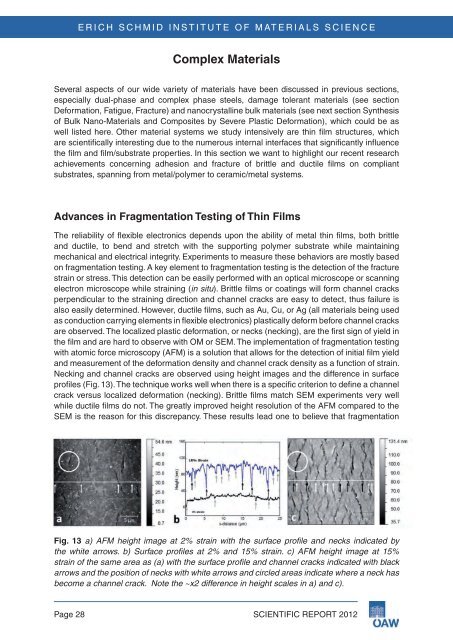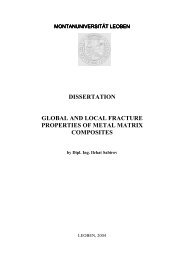Scientific Advisory Board - Erich Schmid Institute
Scientific Advisory Board - Erich Schmid Institute
Scientific Advisory Board - Erich Schmid Institute
You also want an ePaper? Increase the reach of your titles
YUMPU automatically turns print PDFs into web optimized ePapers that Google loves.
ERICH SCHMID INSTITUTE OF MATERIALS SCIENCE<br />
Complex Materials<br />
Several aspects of our wide variety of materials have been discussed in previous sections,<br />
especially dual-phase and complex phase steels, damage tolerant materials (see section<br />
deformation, fatigue, fracture) and nanocrystalline bulk materials (see next section Synthesis<br />
of Bulk nano-materials and composites by Severe plastic deformation), which could be as<br />
well listed here. other material systems we study intensively are thin film structures, which<br />
are scientifically interesting due to the numerous internal interfaces that significantly influence<br />
the film and film/substrate properties. in this section we want to highlight our recent research<br />
achievements concerning adhesion and fracture of brittle and ductile films on compliant<br />
substrates, spanning from metal/polymer to ceramic/metal systems.<br />
Advances in Fragmentation Testing of Thin Films<br />
the reliability of flexible electronics depends upon the ability of metal thin films, both brittle<br />
and ductile, to bend and stretch with the supporting polymer substrate while maintaining<br />
mechanical and electrical integrity. experiments to measure these behaviors are mostly based<br />
on fragmentation testing. A key element to fragmentation testing is the detection of the fracture<br />
strain or stress. this detection can be easily performed with an optical microscope or scanning<br />
electron microscope while straining (in situ). Brittle films or coatings will form channel cracks<br />
perpendicular to the straining direction and channel cracks are easy to detect, thus failure is<br />
also easily determined. However, ductile films, such as Au, cu, or Ag (all materials being used<br />
as conduction carrying elements in flexible electronics) plastically deform before channel cracks<br />
are observed. the localized plastic deformation, or necks (necking), are the first sign of yield in<br />
the film and are hard to observe with om or Sem. the implementation of fragmentation testing<br />
with atomic force microscopy (Afm) is a solution that allows for the detection of initial film yield<br />
and measurement of the deformation density and channel crack density as a function of strain.<br />
necking and channel cracks are observed using height images and the difference in surface<br />
profiles (fig. 13). the technique works well when there is a specific criterion to define a channel<br />
crack versus localized deformation (necking). Brittle films match Sem experiments very well<br />
while ductile films do not. the greatly improved height resolution of the Afm compared to the<br />
Sem is the reason for this discrepancy. these results lead one to believe that fragmentation<br />
Fig . 13 a) AFM height image at 2% strain with the surface profile and necks indicated by<br />
the white arrows. b) Surface profiles at 2% and 15% strain. c) AFM height image at 15%<br />
strain of the same area as (a) with the surface profile and channel cracks indicated with black<br />
arrows and the position of necks with white arrows and circled areas indicate where a neck has<br />
become a channel crack. Note the ~x2 difference in height scales in a) and c).<br />
page 28 <strong>Scientific</strong> RepoRt 2012

















